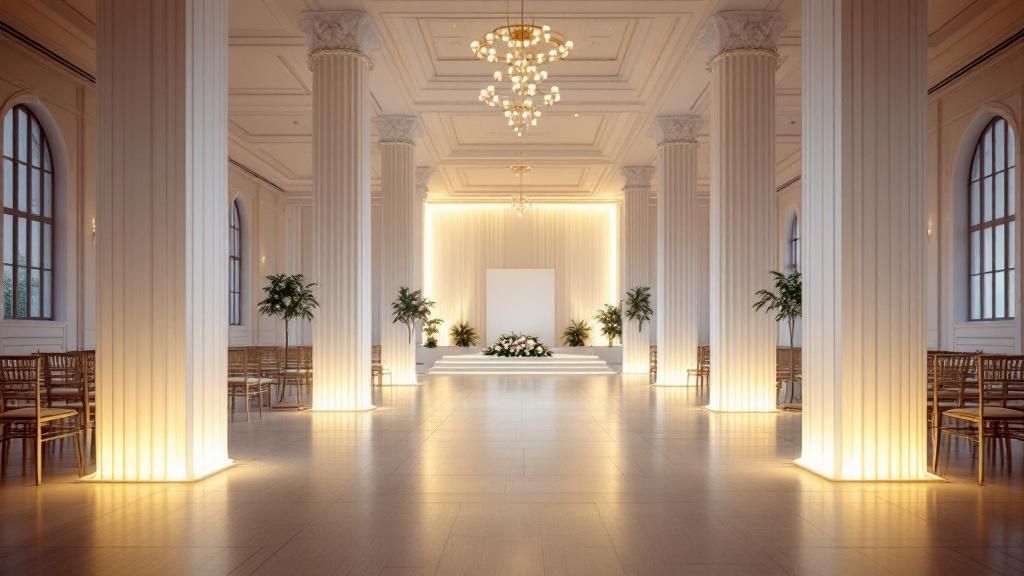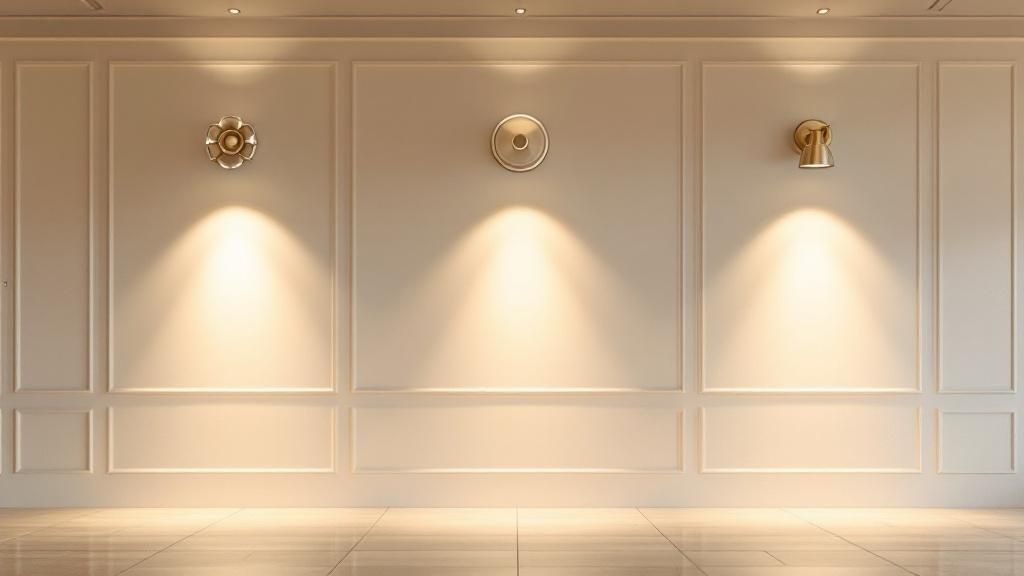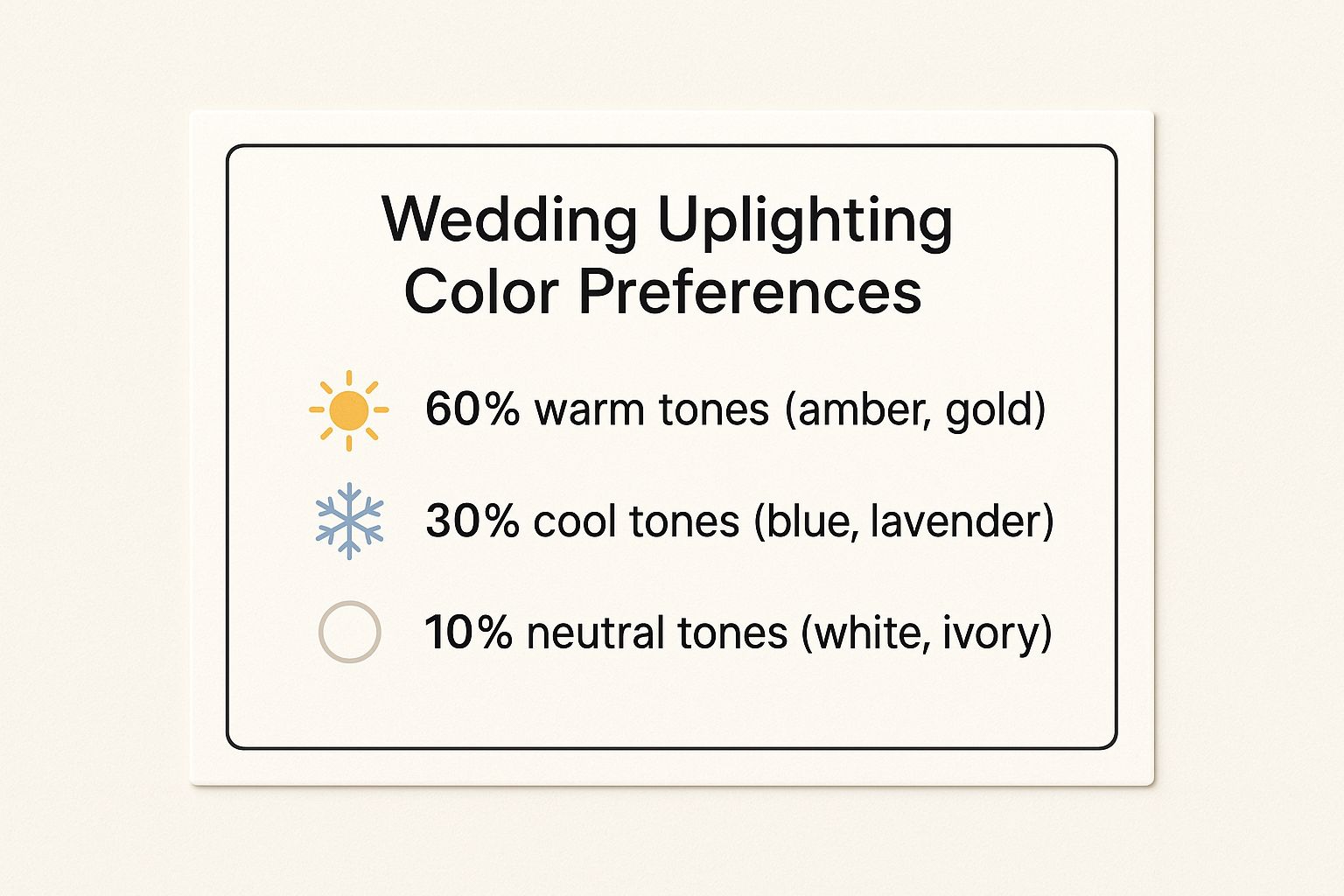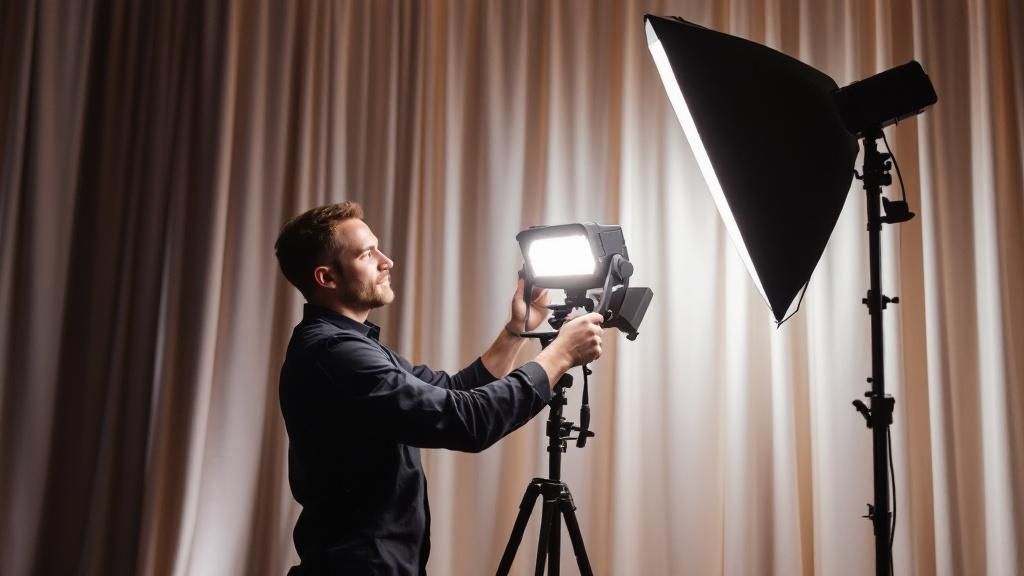Let's be real for a moment. When you first hear the term "uplighting," it might sound like another complicated item on your wedding checklist. But what if I told you it's the single most effective way to completely change the vibe of your venue?
Think of it as literally painting with light. We're talking about placing small, discrete lights on the floor around your room, aiming them straight up. The result? Gorgeous columns of light that wash your walls, pillars, and ceilings in the color of your choice. It's a simple concept with a dramatically transformative effect.
What Exactly Is Wedding Uplighting?

Imagine your venue is a blank canvas. It's beautiful on its own, sure, but uplighting is what adds the emotion, the mood, and the "wow" factor. Forget those standard, often harsh, overhead lights. Uplighting creates a soft, enchanting glow from the ground up.
This approach is brilliant because it lets you play director. You can spotlight the best features of your space—like those stunning architectural columns or intricate wall textures—while hiding anything you're not a fan of. The whole point is to craft an immersive atmosphere that your guests feel the second they walk through the door.
The Real Reason It's A Wedding Game-Changer
Uplighting isn't just about making a room pretty; it's about changing how the space feels. It's a go-to technique for modern weddings because it delivers so much bang for your buck, visually speaking. And it's not just a niche trend anymore—it's quickly becoming a staple of wedding decor.
Uplighting is more than just a passing fad; it's a powerful tool that has reshaped how couples approach venue decoration. In fact, it's estimated that around 40% of weddings in 2025 will feature elaborate lighting designs like uplighting. You can check out more fascinating wedding stats over at Nearlywed.com.
This shift shows that couples are moving toward creating deeply personal and atmospheric events. By bathing your venue in color, every moment feels more special, your photos will absolutely pop, and the entire room will perfectly reflect your vision. It's the design glue that holds everything else together.
To put it simply, here's a quick rundown of what uplighting is all about.
Uplighting At A Glance
| Concept | Brief Explanation |
|---|---|
| What It Is | The technique of placing lights on the floor and aiming them upward to cast columns of colored light on walls, pillars, or other features. |
| Main Purpose | To create a specific mood, add depth, and transform the overall atmosphere of a wedding venue. |
| Key Benefits | Enhances photos, highlights architecture, sets a cohesive theme, and creates an immersive experience for guests. |
Essentially, uplighting gives you the power to customize your space in a way that no other decor element can quite match.
The Real Impact Of Uplighting On Your Wedding
So, you get that uplighting makes a room look pretty, but what does it actually do for your wedding day? This is where the real magic comes in. Think of uplighting as your secret weapon for setting the mood, completely transforming your venue, and making sure your photos are absolutely stunning. It’s not just about splashing some color on the walls; it’s about creating an experience.
Picture this: your reception begins, and the room is bathed in a soft, romantic amber glow for dinner. That warm light instantly makes the space feel intimate and cozy, encouraging guests to relax and chat. Then, when it’s time to party, the lights shift to a cool blue or even a vibrant fuchsia. That’s the signal—it's time to get on the dance floor. Being able to change the entire atmosphere with the flip of a switch is what makes professional lighting so incredibly powerful.
From Bland Ballroom to Breathtaking Venue
Let's be honest, every venue has its beautiful features… and its not-so-beautiful ones. Uplighting is how you highlight the good and hide the bad. Think of it as your personal art director for the space. Got gorgeous architectural columns? Let's make them pop. That plain, boring wall over there? Let's wash it in a beautiful color so it becomes an intentional part of the decor.
With just a few strategically placed lights, you can completely change the feel of a room.
- Add Depth and Dimension: Rooms with flat, even lighting can feel a bit sterile, almost like a conference room. Uplighting creates pockets of light and shadow that give the space a much richer, more dynamic feel.
- Define Different Zones: You can use light to visually separate the lounge area from the dance floor or draw everyone’s attention to your head table or that incredible wedding cake you spent so much time choosing.
- Tie Your Theme Together: The colors you pick for your uplighting can bring everything else together. It connects your flowers, your linens, and your other decor into one cohesive, polished look.
For a deeper dive into different lighting setups, check out our guide on wedding reception lighting.
Getting Those Picture-Perfect Photos
This is the part so many couples don't think about until it's too late: your lighting has a massive impact on your wedding photos. Your photographer is a pro, of course, but amazing lighting gives them a much better canvas to work with from the get-go. The soft, colorful glow from uplighting gets rid of harsh overhead shadows and adds a professional, almost cinematic quality to your entire wedding album.
We’re not just saying it looks better—there’s data to back it up. Industry reports show that venues using professional uplighting see up to a 70% improvement in how elegant guests and photographers perceive the space. This directly translates to more stunning photos and a more memorable event. You can see more on this in these 2025 wedding lighting trends.
Instead of photos where the flash washes everything out, you’ll get images filled with rich color and a captivating atmosphere. The background is no longer just a wall; it’s a dynamic, beautiful backdrop that makes you and your guests the true focus. It's that finishing touch that ensures your memories are captured just as beautifully as you remember them.
Choosing Your Uplighting Colors And Gear

Alright, now for the fun stuff! This is where we get to pick the gear and the colors that will completely transform your venue. Knowing a little about the equipment and your color options before you chat with a lighting pro will make the conversation so much smoother. It helps you articulate exactly what you're picturing for your big day.
The heart and soul of any modern uplighting setup is the LED fixture. These are the compact but mighty lights that sit on the floor. The best part? They don't get hot, they sip electricity, and they can mix literally millions of colors. That means your creative options are pretty much endless.
Wired Vs. Wireless Uplights
Your first big decision is whether to go with wired or wireless lights. Honestly, there's no single "best" answer—it all comes down to your venue, your budget, and the look you're going for.
-
Wired Uplights: These are the old-school reliable option. You plug them into a wall outlet, and they'll run all night without a single hiccup. The catch? You're tethered to those outlets, and a lot of planning has to go into hiding all the cords so they don't look messy or become a trip hazard.
-
Wireless Uplights: These are the game-changers. Because they're battery-powered, you can stick them literally anywhere. Behind the head table, in a tight corner, even outside under a tree—no outlet, no problem. This is a massive win for unique venues. The only thing to keep in mind is making sure they have enough juice to last your whole party.
The Bottom Line: For total freedom and a super clean look, wireless uplights are the way to go and are what most couples choose these days. But if your venue has plenty of outlets and a simple layout, wired lights can be a perfectly solid choice. A quick chat with your lighting designer about your venue will clear this up right away.
Selecting Your Perfect Color Palette
Choosing your uplighting color isn't just about matching your flowers or napkins. It’s about painting with light to create a feeling. Don't just think "I want blue." Instead, ask yourself, "What kind of vibe do I want?" Are you going for warm and romantic, or a high-energy party atmosphere?
We dive really deep into this topic in our complete guide to wedding uplighting colors. It's packed with ideas and will help you see how different shades can completely change the feel of a room.
One of my favorite pro tips is to use color to tell the story of your evening. Think of it in three acts:
-
Cocktails & Dinner: Start with something elegant and soft. A warm amber, a classic soft white, or a romantic blush pink makes the room feel cozy and inviting. It's the perfect backdrop for conversation and dinner.
-
Toasts & First Dances: As the focus shifts to key moments, you can subtly dial up the color. Maybe the light becomes a richer shade of your main color behind the head table for speeches, drawing everyone's attention.
-
Party Time! Once the dance floor opens, it's time to let loose. This is when you can bring in the vibrant magentas, deep blues, and electric purples. A good lighting tech can even sync the lights to the music's beat, instantly turning your reception into an epic dance party.
At the end of the day, it's this thoughtful combination of the right gear and the right colors that takes a wedding from just "pretty" to absolutely unforgettable.
Where To Place Uplights For Maximum Wow Factor
So, you’ve picked your colors and fixtures—now for the fun part. Where do you actually put the lights? Honestly, this is where the real magic happens. Great lighting isn't just about having the gear; it's about being smart with where you place it. Think of it like being a film director for your own wedding, using light to tell everyone, "Hey, look over here!"
The right placement can make a room feel bigger, cozier, or way more dramatic. It's all about playing up your venue's best features. A little bit of strategy goes a long way, transforming a nice space into a truly custom atmosphere that looks absolutely incredible, especially in your photos.
High-Impact Placement Zones
If you want to get the biggest bang for your buck, you'll want to focus on a few key areas that naturally grab people's attention. Putting lights in these spots ensures you're enhancing the parts of the room that will have the most significant visual impact.
These are the go-to locations that lighting pros almost always target first:
- Architectural Columns: Got columns? Light 'em up! This turns them from simple structural posts into grand, elegant features that add a ton of drama.
- Head Table Backdrop: This is a big one. Washing the wall behind your head table in a soft glow creates a gorgeous focal point for all those toasts, speeches, and candid photos.
- Grand Entrance: Set the vibe from the second your guests walk in. A few well-placed lights at the reception entrance immediately says, "The party starts here."
- Dance Floor Perimeter: Framing the dance floor with uplights creates an energetic, defined space that just pulls people in and gets them moving.
To get a better sense of how different colors look in action, here’s a quick peek at what other couples are loving right now.

As you can see, there’s a clear lean towards those warm, romantic tones like amber and gold. You really can't go wrong with them for creating a timeless, inviting glow.
The Art of Spacing Your Lights
Beyond just picking the spots, the distance between your lights—what we call spacing—is just as important. This single detail is what fine-tunes the overall effect. A few feet difference can completely change the look of your room, which is what makes uplighting so cool and versatile.
Want distinct "pillars" of light for a bold, architectural feel? Or do you prefer a seamless "wash" of color that covers the whole wall? This is a key conversation to have with your lighting designer. They’ll place the lights farther apart for pillars or closer together for a color wash.
To help you figure out the best spots in your venue, I've put together a little cheat sheet. It’s a simple guide to help you match placement with the effect you're trying to achieve.
Uplighting Placement Cheat Sheet
| Placement Area | Desired Effect | Pro Tip |
|---|---|---|
| Behind the Head Table | Creates a focal point; looks amazing in photos. | A full color wash works wonders here. It softens the background for speeches and toasts. |
| Architectural Columns | Adds drama and highlights venue features. | Place one light at the base of each column to shoot light straight up. |
| Along Bare Walls | Fills empty space and makes the room feel cohesive. | Space lights 8-10 feet apart for a "pillar" look or 4-6 feet apart for a smooth "wash." |
| Around the Dance Floor | Defines the party area and builds energy. | Position lights in the corners, aimed inward. This frames the space without blinding dancers. |
| At the Entrance | Welcomes guests and sets the initial mood. | Two lights flanking the doorway create a beautiful, symmetrical first impression. |
| Cake or Dessert Table | Draws attention to the sweet treats. | Use one or two lights to gently highlight the table, making the cake a true centerpiece. |
Thinking through these key areas will help you and your lighting pro map out a plan that feels intentional and looks spectacular.
Focusing on these high-impact zones and making smart calls on spacing is how you get a design that really elevates your venue. If you're looking for more inspiration, you might want to check out these creative wedding uplighting ideas to see what’s possible.
Budgeting For Your Wedding Uplighting

Alright, let's talk about the elephant in the room: money. When you're in the thick of wedding planning, it’s so easy to see uplighting as just another line item on a growing list of expenses. But trust me, it’s much more helpful to think of it as an investment—an investment in the whole vibe of your reception and the experience you're creating for your guests.
There’s no magic number for what uplighting costs. The final price tag is shaped by a few key things, and knowing what they are will help you have a much better chat with your lighting designer and set a budget that makes sense for this huge-impact detail.
Key Factors That Influence Cost
The price for professional uplighting can swing quite a bit, but it really boils down to a handful of core elements. As you can imagine, a more complex setup will cost more, but it also gives you a completely custom-designed atmosphere.
Here’s a peek into what vendors are looking at when they put your package together:
- Number of Lights: This is the most straightforward factor. A cozy, intimate room might only need 10-12 lights to feel complete. A grand ballroom? You could be looking at 24 or more to really wash the space in color.
- Venue Size and Layout: Big venues with soaring ceilings, architectural columns, or other unique features will naturally need more lights to cover the area and draw attention to all those cool details.
- Wireless vs. Wired Fixtures: Modern, battery-powered wireless lights are fantastic. They offer total placement flexibility and a super clean look with no visible cords. They do, however, often cost a bit more than traditional plug-in fixtures.
- A Dedicated Technician: If you want your lighting to change throughout the night—say, from a warm, romantic amber during dinner to vibrant, pulsing colors for dancing—you'll need a pro on-site to run the show.
On average, you can expect to budget anywhere from $25 to $75 per light fixture. Many event companies and DJs bundle these into packages, which can be a great value, often landing somewhere between $600 to over $2,000 for a full room design.
Smart Ways To Maximize Your Budget
Getting that "wow" factor doesn't have to mean blowing your budget. There are some really clever ways to get the most visual punch from your lighting investment. It's all about being strategic.
One of the smartest moves is to bundle your services. Many DJs and full-service event companies (like us!) offer lighting as part of a package deal with their other services. This can save you a good chunk of change and makes your life easier with one less vendor to manage.
Another great tip? Focus your lights on high-impact areas. You don't always need to light up every single wall. By concentrating the fixtures on the backdrop behind your head table, the cake display, and the dance floor, you create powerful focal points that anchor the entire room's design. If you want some inspiration, check out some creative wedding uplighting ideas to see what feels right for your day.
DIY Uplighting vs. Hiring A Lighting Pro
Ah, the classic wedding question: "Could we just do this ourselves?" It’s a totally fair thought, especially when you're watching every dollar in the budget. When it comes to something as impactful as uplighting, the decision between renting some lights yourself and bringing in a pro really boils down to what you value most: cost, convenience, or your own sanity on the big day.
Going the DIY route can definitely look appealing on paper. You rent a box of lights, you set them up, and you save some cash. You're in total control. But before you jump on that, it’s worth thinking about what that really looks like.
The Realities Of DIY Uplighting
Let's be honest, the biggest hurdles with DIY are the logistics and the stress. You're suddenly in charge of everything. That means finding a reputable rental company, picking up the gear, and then figuring out the whole setup. We're talking about placing the lights, running all the power cables, and taping them down so Grandma doesn't trip—all while you’re supposed to be getting your hair and makeup done.
And it doesn't end when the party does. After you’ve danced your heart out, the last thing you'll want to do is start coiling cables and packing up a dozen light fixtures. What if a light starts flickering halfway through the toasts? Guess who becomes the on-the-spot tech support? Yep, you or a well-meaning (but probably clueless) groomsman.
The real value of a professional isn't just the fancy equipment they own; it's the expertise and the incredible peace of mind they deliver. They handle the design, the setup, the operation, and the cleanup, letting you actually be at your own wedding.
The Value Of Professional Expertise
This is where hiring a pro like 1021 Events completely changes the game. Uplighting stops being another stressful task on your checklist and becomes a seamless, professionally managed experience. A true lighting designer instinctively knows the best spots to place fixtures for jaw-dropping effect. They know how to hide cables, solve technical glitches in seconds, and ensure the whole look is polished and safe.
Plus, they bring the good stuff—commercial-grade, reliable wireless fixtures that are worlds beyond what you can typically rent yourself.
At the end of the day, you're not just paying for lights. You’re investing in a flawless, worry-free result. For most couples, dodging that day-of stress and guaranteeing the room will look absolutely stunning is worth every single penny. Your wedding day is for making memories, not managing equipment.
Common Questions About Wedding Uplighting
Alright, let's wrap things up by tackling some of the most common questions couples ask about uplighting. Think of this as your final check-in before deciding how to make your venue shine. We'll give you straight answers so you can feel totally confident in your lighting plan.
How Many Uplights Do I Actually Need?
This is easily the biggest question we get, and the honest answer is: it depends! There's no single magic number because every venue and every desired vibe is different.
Looking for a subtle, romantic glow in a smaller, more intimate space? You might be perfectly set with 10-12 lights. But if you're in a grand ballroom and want to completely saturate the walls with color, you're likely looking at 24 or more.
A good rule of thumb is to place one light every 8-10 feet for a dramatic "pillar" effect. If you want a smooth, seamless wash of color, you'll want to space them closer, about every 4-6 feet.
Does Uplighting Even Work for Outdoor Weddings?
Absolutely! Modern uplighting isn't just for ballrooms anymore. The invention of wireless, battery-powered fixtures was a game-changer for outdoor events.
We can place them anywhere without worrying about tripping hazards or finding an outlet. They're perfect for lighting up majestic trees, the inside of a tent, or the cool architectural details of a historic building. It adds a whole new layer of magic to an open-air reception.
Will Uplighting Ruin My Wedding Photos?
Let's bust this myth right now. I hear this concern a lot, and it usually comes from seeing photos from a wedding with bad, amateur lighting. When done poorly, yes, colored light can make people look like aliens.
But when it's done by a professional, the exact opposite is true. Professional-grade uplighting is designed to elevate your photos, not ruin them. It adds depth, dimension, and an incredible atmospheric glow that a camera flash alone just can't produce.
Here's the secret: an experienced wedding photographer knows how to balance their flash with the room's ambient light. They'll use their flash to perfectly light you and your guests in the foreground, while using a slightly slower shutter speed to soak up all that beautiful, colorful uplighting in the background.
The result isn't weird skin tones. It's a rich, vibrant backdrop that makes your photos pop and truly captures the energy and feeling of your celebration. You can see more examples and dive deeper into this in our complete guide on uplights for weddings.
Ready to see how incredible lighting can transform your venue? The team at 1021 Events has the professional gear and the know-how to bring your vision to life. We handle all the details so you can have a stress-free experience and an unforgettable atmosphere. Find out how we can make your wedding glow at https://www.1021events.com.

